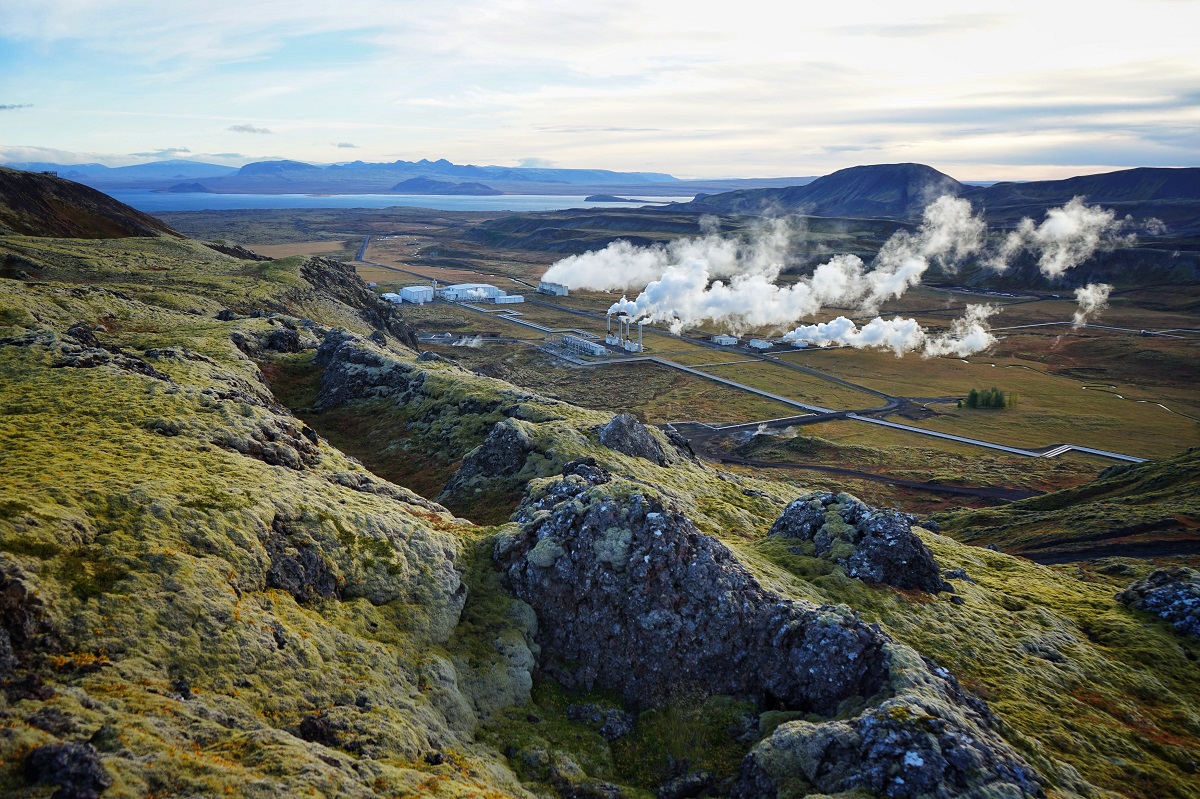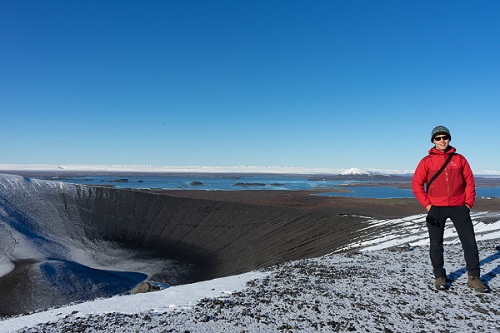
The Nesjavellir geothermal plant in Reykjavik, Iceland was the second stop on Finley's journey. Photo by Theron Finley.
Steam pours from pipes criss-crossing a snow-covered field in Iceland. The sun beats down on patchy shrubs in the Nevada desert. Mountains pierce a blanket of low clouds in southern Germany. What do these locations all have in common? They're each a source of geothermal power-and they've all been visited by one University of Alberta student.
Over the past year, geoscience master's student Theron Finley circled the globe in search of such diversity, travelling from Alaska to New Zealand to broaden his understanding of geothermal energy exploration around the world—and purchasing carbon offsets to compensate for the travel involved in his geothermal resources research.
"It was five months of travel in total," explains Finley, who is currently finishing his thesis under the supervision of Stephen Johnston ('85 MSc, '93 PhD) (earth and atmospheric sciences) and Martyn Unsworth (earth and atmospheric sciences and physics). "It was so exciting and overwhelming at times. I moved to a new location every week or 10 days, either within a country or from one country to another. There were many new faces and new names every day."
Which was, of course, the whole idea-being exposed to as many places and perspectives as possible.
Finley's journey began in Alaska in September 2018, where he met with researchers at the Alaska Center for Energy and Power, and visited several hot springs where geothermal energy is harnessed for use in small, remote communities. The second leg took him to Iceland, where he spent time with the Iceland GeoSurvey in Akureyri, learning about their efforts to find additional hot water for their district heating system. Finley then returned to the southwestern United States for nearly a month, visiting research institutions in Nevada, Utah, and California, before journeying across the Atlantic to Germany and Norway. After a brief break from travels over the holidays in December, Finley made the trek to New Zealand, where he spent nearly a month learning how geothermal energy provides nearly 20 per cent of the nation's energy.
"It's a common adage in geology that the more rocks you see, the better geologist you'll be," explains Finley, who is home in Canada for the foreseeable future. "While I wasn't looking at rocks the entire time, the idea still applies. If you limit your scope too much, you'll miss out. Every place that I went had different perspectives on geothermal energy-what made a good geothermal resource, what sort of science is required to explore it properly, and what are the economics that make it feasible."
So how does a graduate student financially manage a half-year, round-the-world trip during his master's studies? This life-changing experience was made possible by the Hugh Morris Fellowship, offered by the Kimberley Foundation. The fellowship supports Canadian graduate students on a program of self-guided travel and experiential learning with a focus on global sustainability. It is named for Hugh Morris, who, as a PhD student studying geology at the University of the Witwatersrand in South Africa from 1954 to 1958, visited 65 per cent of mines in North America on a similar fellowship experience.
Hot topic
Planes, Trains, and Automobiles
Graduate student Theron Finley traveled to five countries on three continents on his journey to understand geothermal energy around the world. It took 25 flights, many train rides, and countless steps. "Believe it or not, I didn't lose my luggage or miss a connection even once," says Finley.
Theron's Itinerary
↠ 10 days in Fairbanks, Alaska
↠ 10 days in Akureyri, Iceland
↠ 14 days in Reno, Nevada
↠ 7 days in Salt Lake City, Utah
↠ 7 days in Berkeley, California
↠ 7 days in Karlsruhe, Germany
↠ 7 days in Munich
↠ 7 days in Berlin
↠ 7 days in Trondheim, Norway
↠ 25 days in New Zealand
Instead of mining, however, Finley's trip was focused on geothermal energy-a renewable energy source that taps into the heat present in the Earth's crust. Geothermal energy is a promising source of consistent power and heat that produces few greenhouse gas emissions. It can contribute to existing power grids, power remote off-grid communities, be used as a direct source of heat for homes and businesses alike, and facilitate food production.
"Some of the places that I visited have been using geothermal energy for decades," explains Finley. "They're dealing with totally different features with high volume and temperature of water-for example, at active volcanoes. These are more traditional resources, whereas places like Canada and Germany have more unconventional, lower temperature, less obvious resources, and have only recently started investing in this type of energy."
While Canada is not rife with resources such as volcanoes, new approaches to harnessing geothermal power have been successful with the more marginal resources that exist here.
"Theron's fellowship has given him an invaluable opportunity to learn about the global status of geothermal energy," added Unsworth. "He has used this opportunity to learn how this technology can fit into the future of Canadian energy production."
"In Munich, for example, they are drilling wells for less than ten megawatts of power, to provide electricity for something more like a thousand homes. It's a much smaller scale than in say, Iceland, but done multiple times, it becomes very useful," says Finley. "It is a different playing field. We're not finding hundreds of megawatts of power, but these models hold a lot of promise for us here in Canada."
Home-grown research
Back at home, Finley is hard at work on his master's thesis in advance of his defense in early 2020. His research is focused on mapping potential geothermal resources in British Columbia.
"There are many valleys associated with fault zones in southeastern B.C., and we believe these faults can control certain types of geothermal resources," Finley explains. "There has been some fascinating research done in Nevada with mapping fault zones, using these maps to predict the location for geothermal upwellings, and we are hoping to apply something similar in B.C."
Faults allow hot water to flow through the ground, beneath the surface. By mapping faults, researchers may be able to predict where geothermal resources are accessible from the surface, identifying locations where geothermal wells can be drilled. This approach reduces costs and environmental impact, making the resource all the more appealing to industry and local governments.
"Theron's research into geothermal energy sources gives me great hope and confidence regarding our ability to deal with climate change," adds Johnston. "What Theron is doing is nothing less than forging a new, low-carbon energy future for Canada."
To infinity
Reflecting on his international expedition, Finley notes that his horizons have been broadened beyond just the science.
"Seeing things from a new perspective, whether it's how someone approaches science or seeks to answer questions or what different techniques they use, has been a great experience. Beyond the geothermal scientific aspect of this experience, it's also just been an amazing opportunity for personal growth. I'm more confident in myself as a scientist."
